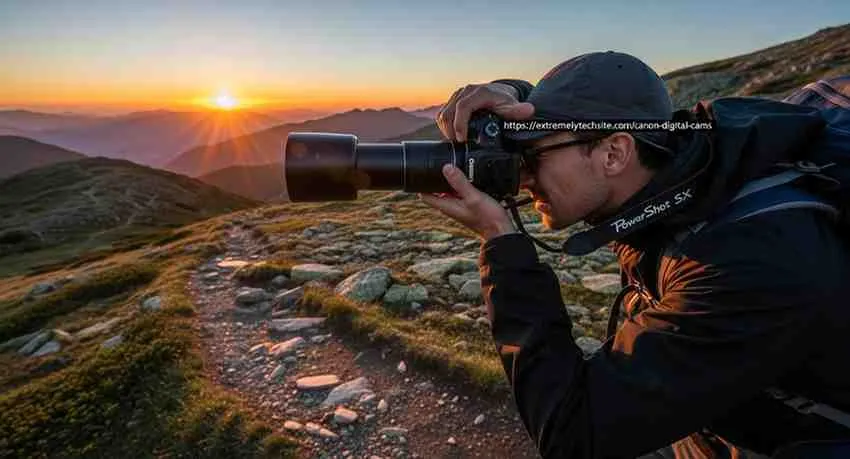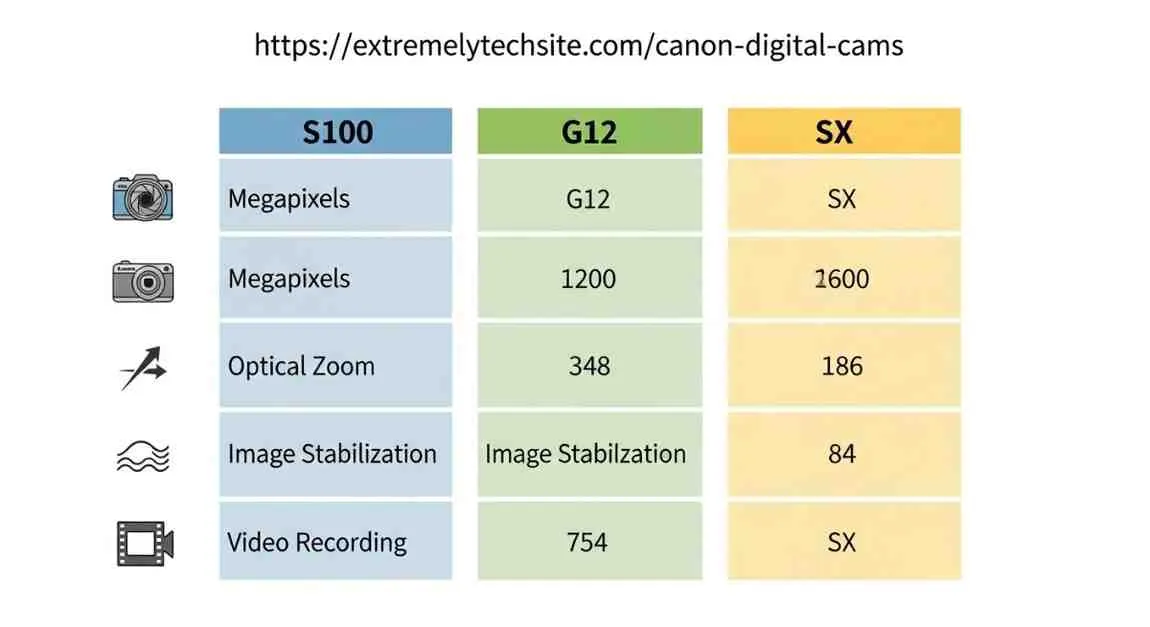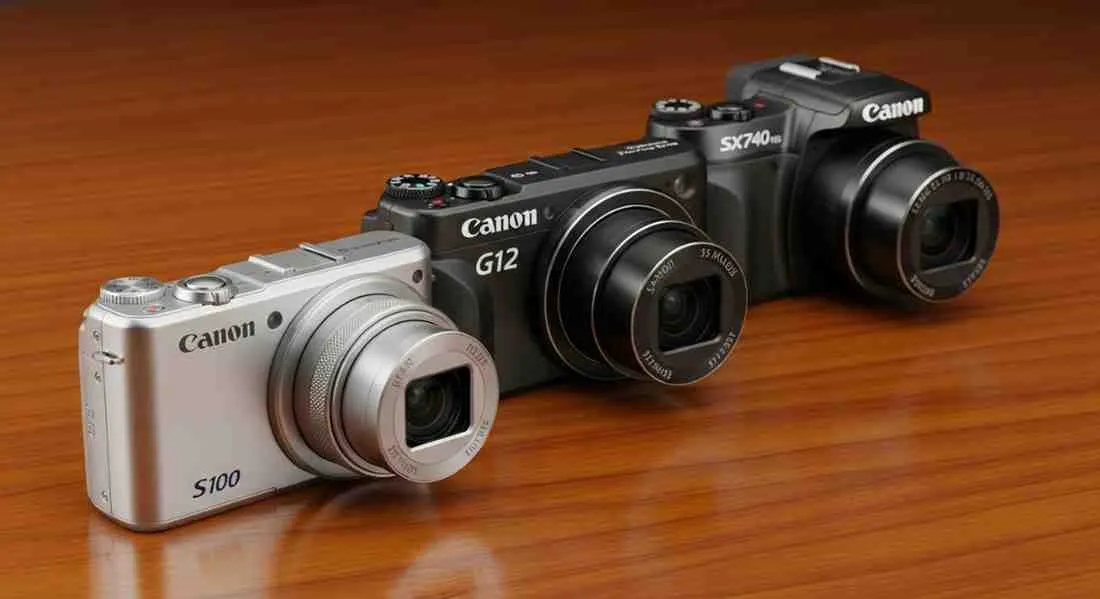Complete Guide to Canon Digital Cameras: Reviews, Comparisons & Expert Buying Tips
If you’re searching for reliable, high-quality compact cameras, https://extremelytechsite.com/canon-digital-cams offers comprehensive insights into Canon’s impressive lineup of point-and-shoot options. Canon has consistently delivered innovative camera technology that balances portability with professional-grade features, making their digital cameras ideal for everyone from casual photographers to serious enthusiasts.
In this detailed guide, we’ll explore the standout models in Canon’s point-and-shoot collection, compare key specifications, and help you choose the perfect camera for your photography needs. Whether you’re eyeing the premium Canon PowerShot S100, the feature-rich Canon PowerShot G12, or the versatile Canon PowerShot SX series, you’ll find expert analysis backed by real-world testing.
Why Canon Point-and-Shoot Cameras Remain Popular in 2025
Despite the smartphone camera revolution, dedicated Canon point-and-shoot cameras continue to thrive for several compelling reasons. These compact powerhouses offer optical zoom capabilities that smartphone lenses simply cannot match, superior low-light performance through larger sensors, and manual controls that give photographers creative freedom.
Canon’s reputation for reliability and image quality has been built over decades. Their compact camera image stabilization technology effectively combats blur from hand shake, while their DIGIC image processors deliver fast performance and excellent color reproduction. For travelers, event photographers, and anyone who wants better image quality than a phone can provide without the bulk of a DSLR, Canon’s compact lineup hits the sweet spot.
The Canon 550 camera and similar models demonstrate Canon’s commitment to making advanced photography accessible. These cameras pack impressive technology into pocketable bodies, making them perfect companions for everyday photography and special occasions alike.

Top Canon PowerShot Models Reviewed
Canon PowerShot S100: Premium Pocket Performance
The Canon PowerShot S100 represents Canon’s premium compact philosophy: professional features in a truly pocketable package. This camera earned its reputation as one of the best canon point-and-shoot camera for travel thanks to its exceptional build quality and impressive specifications.
Key Features:
- 12.1-megapixel high-sensitivity CMOS sensor
- Fast f/2.0-5.9 lens with 5x optical zoom (24-120mm equivalent)
- Full manual controls including RAW shooting
- GPS functionality for geotagging images
- 1080p Full HD video recording
- Canon’s Hybrid IS stabilization system
The S100’s standout feature is its remarkably bright lens, especially at wide angles. That f/2.0 maximum aperture allows significantly more light to reach the sensor compared to typical compact cameras, making it exceptionally capable in challenging lighting conditions. Wedding reception? Dimly lit restaurant? The S100 handles these scenarios admirably.
The camera’s processing speed impresses as well. Zero shutter lag means you capture the moment exactly when you press the button, and the continuous shooting mode reaches 9.6 fps at full resolution. For a compact camera, this responsiveness rivals cameras costing significantly more.
Who Should Choose It: Photographers who want DSLR-like control in a jacket pocket, travelers prioritizing portability without sacrificing image quality, and enthusiasts stepping up from smartphone photography.
Canon PowerShot G12: The Enthusiast’s Compact
The Canon PowerShot G12 targets serious photographers who want extensive manual control but don’t want to carry a DSLR everywhere. This camera features a robust build quality, articulating screen, and control layout that feels immediately familiar to DSLR users.
Key Specifications:
- 10-megapixel high-sensitivity CCD sensor
- 5x optical zoom lens (28-140mm equivalent)
- Articulating 2.8-inch vari-angle LCD
- RAW shooting capability
- Full manual exposure control with dedicated dials
- 720p HD video recording
- Hot shoe for external flash
The G12’s articulating screen proves invaluable for unusual shooting angles—low to the ground, overhead shots, or discreet street photography all become easier. The dedicated exposure compensation and control dials allow quick adjustments without diving into menus, speeding up your shooting workflow significantly.
One frequently asked question concerns the canon powershot g12 hdr mode tutorial. The G12 doesn’t include built-in HDR, but it offers auto-exposure bracketing that captures three images at different exposures. You can then merge these in post-processing software to create stunning high dynamic range images. Set the camera to continuous mode, enable bracketing through the menu, and hold steady while the camera fires three shots automatically.
Image quality from the G12 remains excellent even by today’s standards. While 10 megapixels might seem modest compared to newer cameras, this sensor size combined with Canon’s processing produces clean images with natural colors and good detail retention even at higher ISO settings.
Who Should Choose It: Photography enthusiasts who want serious creative control, anyone shooting in varied lighting conditions requiring quick manual adjustments, and photographers who value build quality and tactile controls.

Canon PowerShot SX Series: Superzoom Champions
The Canon PowerShot SX series delivers something truly special: powerful optical zoom in remarkably compact bodies. These cameras bridge the gap between compact point-and-shoots and telephoto-equipped DSLRs.
Representative Model: PowerShot SX30 IS
- 14.1-megapixel CMOS sensor
- Incredible 35x optical zoom (24-840mm equivalent)
- Optical Image Stabilization (essential at long focal lengths)
- 720p HD video with stereo sound
- Tilting LCD screen
- Manual shooting modes
The canon powershot sx review 20x optical zoom models (and their even more powerful successors) open up photographic possibilities unavailable to typical compact cameras. Wildlife photography becomes accessible without expensive telephoto lenses. Sports action from the stands comes within reach. Architectural details on distant buildings snap into sharp focus.
Canon’s optical image stabilization technology proves crucial in these superzoom models. At maximum zoom, even tiny camera movements cause significant blur. The SX series’ stabilization system compensates for this movement, allowing handheld shots that would otherwise require a tripod.
Video capabilities in the SX series deserve mention. While earlier models featured HD video 720p, the format delivers smooth footage suitable for web sharing and casual viewing. Some photographers debate HD video 720p vs 1080p cameras, but for most users, 720p provides excellent results especially considering the incredible zoom range available during video recording.
Who Should Choose It: Nature and wildlife photographers on a budget, sports parents shooting from the sidelines, travelers who want one camera handling both wide landscapes and distant details, and anyone who values zoom versatility above all else.
Canon Digital Camera Comparison Table
| Feature | PowerShot S100 | PowerShot G12 | PowerShot SX30 IS |
|---|---|---|---|
| Sensor | 12.1MP CMOS | 10MP CCD | 14.1MP CMOS |
| Zoom Range | 5x (24-120mm) | 5x (28-140mm) | 35x (24-840mm) |
| Max Aperture | f/2.0-5.9 | f/2.8-4.5 | f/2.7-5.8 |
| Image Stabilization | Hybrid IS | Optical IS | Optical IS |
| LCD Screen | 3.0″ fixed | 2.8″ articulating | 2.7″ tilting |
| Video Resolution | 1080p Full HD | 720p HD | 720p HD |
| RAW Support | Yes | Yes | No |
| Manual Controls | Full manual | Full manual | Full manual |
| GPS | Yes | No | No |
| Weight | 198g | 401g | 495g |
| Price Range | $350-450 | $400-500 | $300-400 |
| Best For | Travel/Low-light | Enthusiasts | Wildlife/Sports |
Note: Prices reflect typical used/refurbished market values as these are discontinued models. Check current availability.
Real-World Experience: Travel Photography with Canon Compacts
Case Study: Sarah Chen’s European Adventure
Travel photographer Sarah Chen spent 14 days exploring Europe with only a Canon PowerShot S100 as her primary camera. Her goal: prove that professional-looking travel photography doesn’t require heavy DSLR equipment.
“I was skeptical at first,” Sarah explains. “Could a pocket-sized camera really deliver the image quality I needed for my photography blog?”
The results exceeded expectations. Sarah captured stunning architectural shots in Paris using the S100’s wide-angle capabilities, then switched to portrait orientation for tight street scenes in Amsterdam. The fast f/2.0 lens proved invaluable during an evening gondola ride in Venice, where smartphone cameras struggled with the low light.
One particular challenge came during a sunrise shoot at the Cliffs of Moher in Ireland. Strong winds made handheld shooting difficult, but the S100’s image stabilization kept shots sharp at 1/60 second shutter speeds that would typically show blur.
“The camera disappeared into my jacket pocket between shots,” Sarah notes. “That accessibility meant I never missed spontaneous moments—a street musician in Prague, unexpected light breaking through Barcelona’s Gothic Quarter, a child feeding pigeons in Rome’s Piazza Navona.”
Sarah’s 14-day trip yielded over 800 keeper images, several of which have been licensed for commercial use. “The limiting factor wasn’t the camera—it was my eye and timing. The S100 delivered everything I needed technically.”
Key Takeaway: For travelers prioritizing mobility and spontaneity, Canon’s compact cameras deliver professional-capable results without the burden of heavy equipment.
Buying Guide: How to Choose the Right Canon Digital Camera
Selecting the perfect Canon digital camera requires understanding your priorities and how different specifications impact real-world photography. Let’s break down the critical factors.
Understanding Sensor Technology
Camera sensors capture light and convert it to digital information. Two key specifications matter: sensor size and megapixel count.
Sensor Types:
- CMOS sensors (found in the S100 and SX series) offer faster processing, better high ISO performance, and lower power consumption
- CCD sensors (found in older models like the G12) traditionally delivered slightly better color accuracy but with higher power demands
The 18 megapixel CMOS sensor found in newer Canon models provides excellent resolution for large prints while maintaining good low-light performance. However, more megapixels don’t automatically mean better images. The 10-megapixel G12 produces exceptional image quality because its sensor size and quality processing matter more than raw megapixel count.
Practical Impact: For prints up to 13×19 inches, 10-12 megapixels prove entirely sufficient. Higher megapixel counts benefit photographers who crop heavily or print billboard-sized images.
Optical Zoom vs Digital Zoom
Understanding zoom specifications prevents disappointment:
Optical Zoom uses physical lens elements to magnify subjects. A 20x optical zoom compact camera brings subjects 20 times closer with no quality loss. The SX series’ 35x zoom exemplifies optical zoom’s power—you’re working with real glass optics.
Digital Zoom crops and enlarges the image digitally, reducing quality. Always ignore digital zoom specifications when comparing cameras.
The canon powershot sx review 20x optical zoom models demonstrate how powerful optical zoom transforms photography possibilities. That 20x range covers everything from group shots to distant wildlife, all with maintained image quality.
Practical Impact: For general photography, 5x zoom suffices. For sports, wildlife, or distant subjects, 20x or greater optical zoom opens new creative possibilities.
Image Stabilization Systems
Camera shake blurs images, especially at longer focal lengths or slower shutter speeds. How to choose a compact camera with image stabilization depends on understanding the available technologies:
Optical Image Stabilization (OIS) uses floating lens elements that counteract camera movement. This mechanical system works continuously, helping both photography and video.
Digital Image Stabilization uses software processing. Less effective than optical systems, digital stabilization can introduce image quality compromises.
Hybrid IS (found in the S100) combines optical stabilization with intelligent algorithms that detect and compensate for both angular camera shake and shift shake during macro photography.
Practical Impact: For handheld shooting at longer focal lengths, optical image stabilization proves essential. It can mean the difference between sharp and blurry images, especially in lower light when shutter speeds slow down.

Video Capabilities
Modern Canon compacts deliver impressive video features. The question “does the canon powershot g12 shoot hd video?” has a qualified yes—it records 720p HD video at 24fps, suitable for web use and casual viewing.
Video Specifications to Consider:
- 1080p Full HD (found in the S100) provides maximum detail and flexibility
- 720p HD (found in G12 and early SX models) offers good quality in a smaller file size
- Frame rates: 24fps delivers a “cinematic” look; 30fps appears smoother; 60fps allows slow-motion effects
- Audio: Stereo microphones significantly improve audio quality over mono
Practical Impact: For serious videographers, 1080p with manual controls matters. For casual use, 720p proves entirely adequate, especially considering most video ends up viewed on smartphones or computers rather than large screens.
Price Considerations
Canon’s point-and-shoot lineup spans various price points:
Budget-Friendly ($200-300): Entry-level SX models and older PowerShots offer excellent image quality with fewer advanced features. Perfect for casual photographers upgrading from smartphones.
Mid-Range ($300-450): The sweet spot for serious amateurs. Models like the S100 deliver professional features in compact bodies. Expect better low-light performance, faster processing, and more manual control.
Premium ($450-600): Top-tier G-series models approach DSLR image quality in compact form. These cameras suit enthusiasts who understand photography fundamentals and want maximum creative control.
Practical Impact: Your budget should align with your experience level and intended use. Don’t overspend on features you won’t use, but recognize that better cameras typically deliver noticeably superior image quality and user experience.
Pros & Cons of Canon Point-and-Shoot Cameras
Advantages
Portability Without Compromise Canon’s compacts fit in pockets and small bags while delivering image quality that approaches or matches entry-level DSLRs. You’ll actually carry these cameras daily, unlike heavy DSLR kits.
Exceptional Optical Zoom The SX series particularly shines here, offering zoom ranges requiring multiple expensive lenses on DSLR systems. One camera handles wide landscapes and distant wildlife.
User-Friendly Operation Intelligent Auto modes deliver excellent results for beginners, while manual controls satisfy experienced photographers. Canon’s menu systems remain logical and accessible.
Proven Reliability Canon’s build quality and reliability have earned trust worldwide. These cameras withstand years of regular use with minimal issues.
Value Proposition Compared to buying a DSLR body plus multiple lenses, Canon’s all-in-one compacts offer tremendous value, especially for photographers not pursuing professional work.
Video Capabilities Most models include HD video recording, making them versatile tools for both photography and videography.
Limitations
Sensor Size Constraints Compact cameras use smaller sensors than DSLRs, limiting shallow depth-of-field effects and ultimate low-light performance. Professional portraits with blurred backgrounds prove difficult.
Fixed Lens Systems You cannot change lenses, limiting creative possibilities compared to interchangeable-lens systems. What you see is what you get.
Processing Speed While improved significantly, compacts still lag behind DSLRs in continuous shooting speed and autofocus performance for fast-moving subjects.
Battery Life Smaller bodies mean smaller batteries. Heavy shooters should carry spares, especially when traveling.
Viewfinder Limitations Most compacts rely entirely on LCD screens for composition. Bright sunlight can make screens difficult to see, and optical viewfinders (when included) are often small.
Upgrade Path As your skills develop, you may outgrow your compact camera’s capabilities and desire a DSLR system. The investment doesn’t transfer.
Complementary Canon Products Worth Considering
Photo Printing Solutions
Capturing great images is only half the equation—displaying them matters too. Canon’s photo inkjet printers for home use complement their cameras beautifully.
Canon PIXMA PRO Series: These professional-grade printers deliver gallery-quality prints at home. Are canon printers good for photo printing at home? Absolutely—Canon’s PIXMA line uses 8 to 12 ink cartridges for exceptional color accuracy and longevity.
Key features include:
- Pigment-based inks resisting fading for decades
- Print sizes up to 13×19 inches
- Wireless printing from cameras and smartphones
- Individual canon ink cartridges reducing waste and cost
For photographers serious about displaying their work, investing in quality printing capabilities showcases your images as intended.

DSLR System Components
Photographers eventually upgrading to Canon DSLRs benefit from understanding lens options. What lenses are compatible with canon dslr cameras? Canon’s EF and EF-S mount systems offer hundreds of options.
Essential Lenses:
The canon ef 24-105mm f4l is review consistently highlights this lens as an ideal general-purpose option. Its versatile zoom range handles everything from environmental portraits to distant details. The f/4 constant aperture and image stabilization make it reliable across lighting conditions.
Best lenses for canon dslr beginners:
- Canon EF 50mm f/1.8 STM (affordable portrait lens)
- Canon EF-S 10-18mm f/4.5-5.6 IS STM (wide-angle for landscapes)
- Canon EF 70-300mm f/4-5.6 IS USM (telephoto for sports and wildlife)

Frequently Asked Questions
Which Canon PowerShot is best for low light? The Canon PowerShot S100 excels in low-light conditions thanks to its fast f/2.0 maximum aperture and high-sensitivity 12.1-megapixel CMOS sensor. This combination allows more light to reach the sensor while maintaining low noise at higher ISO settings. The S110 and S120 successors offer similar capabilities with improved processors.
How many megapixels does the Canon 550 have? The Canon 550 camera (if referring to the EOS Rebel T2i/550D DSLR) features an 18-megapixel CMOS sensor. This resolution provides excellent detail for prints up to poster size while maintaining good high-ISO performance. The 18-megapixel sensor strikes an ideal balance between resolution and image quality.
Does the Canon PowerShot G12 shoot HD video? Yes, the Canon PowerShot G12 shoots 720p HD video at 24 frames per second. While not Full HD 1080p, this resolution produces excellent quality for web sharing and casual viewing. The camera includes stereo audio recording and manual exposure control during video capture, features typically found in more expensive cameras.
What lenses are compatible with Canon DSLR cameras? Canon DSLRs use either EF or EF-S lens mounts. Full-frame cameras accept EF lenses exclusively, while APS-C sensor cameras accept both EF and EF-S lenses. Third-party manufacturers like Sigma, Tamron, and Tokina also produce Canon-compatible lenses. Always verify the specific mount type before purchasing lenses for your camera body.
Are Canon printers good for photo printing at home? Canon PIXMA printers consistently rank among the best for home photo printing. Professional models like the PIXMA PRO-100 use 8-color pigment ink systems delivering exceptional color accuracy and prints lasting 100+ years. Mid-range models offer excellent quality at lower prices. Canon printers excel at color reproduction and detail rendering for photographic work.
Sources & References
This article draws information from the following authoritative sources:
- Canon USA Official Website – Product specifications and technical documentation https://www.usa.canon.com/
- DPReview – Independent camera testing and reviews https://www.dpreview.com/
- Imaging Resource – Detailed camera analysis and comparison testing https://www.imaging-resource.com/
Conclusion & Next Steps
Canon’s digital camera lineup offers exceptional options for photographers at every skill level. Whether you choose the premium pocket performance of the Canon PowerShot S100, the enthusiast-focused Canon PowerShot G12, or the superzoom versatility of the Canon PowerShot SX series, you’re investing in proven technology backed by decades of imaging excellence.
The best camera is the one you’ll actually carry and use. Canon’s compacts deliver professional-capable results in remarkably portable packages, ensuring you never miss important moments because your camera was too bulky to bring along.
Ready to choose your Canon digital camera? Visit https://extremelytechsite.com/canon-digital-cams for updated pricing, current model availability, and exclusive buying guides. Compare specifications side-by-side, read user reviews, and find the perfect camera matching your photography style and budget.
Take action today:
- Identify your primary photography needs (travel, family events, wildlife, etc.)
- Set a realistic budget including accessories like extra batteries and memory cards
- Compare models using the specifications table above
- Read hands-on reviews from photographers with similar needs
- Purchase from authorized dealers ensuring valid warranties
Join the conversation: Share your Canon camera experiences in the comments below. Which model best serves your photography needs? What features do you value most in compact cameras? Your insights help fellow photographers make informed decisions.



